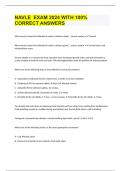NAVLE EXAM 2024 WITH 100% CORRECT ANSWERS
What nerve(s) need to be blocked in order to dehorn cattle? - correct answer ✔✔Cornual
What nerve(s) need to be blocked in order to dehorn goats? - correct answer ✔✔cornual nerve and infratrochlear nerve
Several rabbits in a commercial meat operation have developed genital scabs, perineal ulcerations a crusty exudate around the nose and eyes. Microhemaglutination tests are positive for treponematosis.
Which one of the following steps is most effective to treat this problem? A - Amprolium-medicated feed for whole herd, 2 weeks; Increase ventilation
B - Clindamycin PO for exposed rabbits, 8 days; Cull affected animals
C - Amipcillin PO for affected rabbits, 10-14 days
D - Isolate affected animals, Lincomycin in water 2-3 weeks
E - Penicillin IM for all rabbits, 5-7 days - correct answer ✔✔Penicillin IM for all rabbits, 5-7 days
Two bucket-fed veal calves are depressed and stunted and have sticky feces coating their hindquarters. Fluid-splashing sounds are audible during auscultation over the left flank when a calf is drinking.
Passage of a stomach tube obtains a rancid-smelling liquid with a pH of 5.2 [N=5.9-6.2]
Which one of the following choices is the most appropriate treatment? A - Cull affected calves
B - Remove fermented rumen contents, flush with saline C - Wean affected calves; Shift to bottle-feeding for well calves
D - Vitamin E/Selenium injections, plus dietary supplements
E - Inoculate rumen fluid from a healthy cow into calf by stomach tube - correct answer ✔✔B - Remove fermented rumen contents, flush with saline
This is the clinical picture of a ruminal drinker calf with chronic indigestion from milk deposited directly into the rumen.
Treat by removing the fermented material and flushing the rumen with saline. Attempt to induce gastric/reticular groove closure during feeding by inducing vigorous sucking activity with a finger before feeding milk. If calves relapse, consider weaning. The problem occurs due to failure of the gastric groove reflex, which normally shunts milk directly into the abomasum, (bypassing the rumen). Most often seen in bucket fed calves who gulp their milk.
Abortions due to brucellosis tend to occur at what stage of pregnancy? - correct answer ✔✔D - Last half of pregnancy
Typically, Brucellosis causes abortion in the LAST HALF of pregnancy, for the 5th month onwards. Last trimester is also a good answer, though not entirely correct. You might remember "Bruce is always late".
Expect STILLBORN calves. Cows only abort ONCE.
Brucellosis is REPORTABLE.
The vaccines used are the Brucella abortus strain 19 vaccine or the RB51 vaccine, given to heifer calves 4-12 months old, along with a USDA tattoo in the right ear. Remember: "The right ear is the RIGHT EAR".
BVD and Trichomoniasis (occasionally) can cause early abortion in cows, but MOST things cause abortion
late, like 3rd trimester.
Listeriosis and Arcanobacterium pyogenes can cause abortion at any time during pregnancy. A cow is presented on emergency with urea/non-protein nitrogen toxicity.
What is the treatment of choice? A - Atropine, Protopam chloride IV q 4-6 hours
B - Rumenal infusion 2-8 liters vinegar,3-10 gallons cold water
C - Rumenotomy
D - IV Fluids with MgSO4, Na thiosulfate PO
E - Relieve bloat, drench with 2-8 liters sodium bicarbonate - correct answer ✔✔B - Rumenal infusion 2-
8 liters vinegar,3-10 gallons cold water
A 3-month old calf is presented for necropsy. The calf collapsed and suddenly died this morning after she escaped and was chased around the back pasture for 45 minutes by her owner.
Among other things, endocardial plaques in the left ventricle of this calf's heart are discovered.
What advice should be given the farmer? A - Treat the other calves with vitamin E/Selenium
B - Check the mother for bovine leukosis by AGID
C - Take all the calves off ionophore-containing feed
D - Start the other calves on Ceftiofur (Naxcel ®)
E - Search the calf barn for sources of lead - correct answer ✔✔A - Treat the other calves with vitamin E/Selenium
Treat the other calves with vitamin E/Selenium. Think White Muscle Disease when you see SUDDEN DEATH and endocardial PLAQUES in a young calf, lamb or kid with a history of recent VIGOROUS EXERCISE. Follow this link to a Merck image of pale ventricular myocardium. Typically seen in young, fast-growing animals (ie: calves 2 weeks-6 mos) Clinical signs may include dyspnea (due to myocardial disease), stiff gait, arched back, weakness, recumbent but BAR (bright, alert,
responsive). Sudden death may resemble enterotoxemia, should see acute bloody diarrhea, convulsions, opisthotonos in first days of life with enterotoxemia.
Which pair of neonatal calf diarrheas both have public health/zoonotic significance? A - Colibacillosis, Ostertagiasis
B - Colibacillosis, Rotavirus
C - Cryptosporidiosis, Salmonella
D - Salmonella, Coccidiosis
E - Clostridium perfringens, Coronavirus - correct answer ✔✔C - Cryptosporidiosis, Salmonella
Cryptosporidiosis is caused by a protozoa implicated in drinking water-associated outbreaks of diarrhea in humans; Salmonellae can infect humans from a number of different sources (turtles, chickens, eggs) E. Coli can cause human disease, but Ostertagia and bovine rotavirus do not. (There IS a human version of rotavirus, however) C. perfringens can be found in soil and in the normal gut flora and is not contagious.
Swainsonine is a toxic compound present in which one of the following plants? A - Persea americana (Avocado)
B - Pteridium aquilinum (Bracken fern)
C - Astragalus flavus (Milk vetch)
D - Prunus virginiana (Chokecherry)
E - Nerium oleander (Oleander) - correct answer ✔✔C - Astragalus flavus (Milk vetch)




